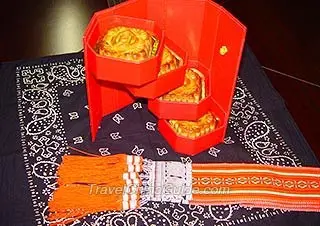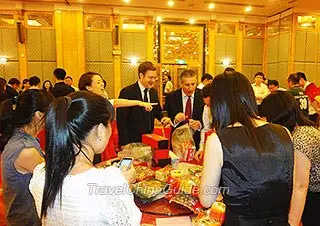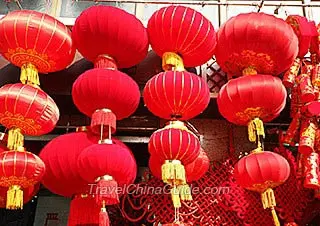Customs on Mid-Autumn Festival
Offering Sacrifice to the Moon
The sacrifice to the moon on the Mid-Autumn Festival has a very long history, which dates back to the Zhou Dynasty (1046 - 256 BC). In ancient times, the emperors usually offered a sacrifice to the moon on the Autumnal Equinox at the place called Altar of the Moon. The Altar of the Moon in Beijing was where the emperors of the Ming (1368-1644) and Qing (1644-1911) Dynasties offered a sacrifice to the moon. Through the passage of time, this Mid-Autumn Festival custom has been adopted into folk lore and now the sacrificial ceremony is usually held in family units. However, nowadays this activity continues only in certain rural areas or at attraction sites and no longer by the majority of Chinese families.
With the announcement by the host, the ceremony began. Two deacons walked slowly to stand one each side of the offering table, followed by the officiant (usually the oldest woman in the family or the hostess) and the other attendants (family members), who all went down on their knees in front of the offering table. The officiant then took over three burning joss sticks from the deacon and made some wishes and then placed the joss sticks in the burner. This would be done three times. Then the officiant poured a cup of wine in front of the offerings and read prayers toward the moon. The paper with written prayers was then burnt, together with moonlight papers (the incense papers painted with the moon palace and goodness of the moon). After, all attendants genuflected three times. Finally, the attendants burnt the incense, made wishes and worshiped the moon one by one.
|
|
Appreciating the Moon
Compared with the moon sacrificial ceremony, the custom of appreciating the moon is much more popular among modern people. The family members sit around a table and appreciate the moon, while talking to each other and eating the offerings from the ceremony, etc. This Mid-Autumn Festival custom was actually derived from the sacrificial ceremony, which made a serious activity into a relaxing one. It started in the Three Kingdoms Period (220 - 280 AD) to the Jin Dynasty (265 - 420 AD). In the Tang Dynasty (618 - 907 AD), the custom became very popular. There are many works of literature of that time praising the moon and expressing yearnings to distant relatives and friends. It was during the Song Dynasty (960-1279 AD) that a folk festival involving appreciation of the moon was formed and it became the earliest official Mid-Autumn Festival.
Eating Moon Cakes
The origin is attributed to the victorious insurrectionary army of the Yuan Dynasty (1271 - 1368 AD) that had passed messages by hiding notes in moon cakes. As gifts, the leader gave moon cakes to his subordinates on the coming Mid-Autumn Festival. Since then, the custom of eating moon cakes on Mid-Autumn Day became established. In following eras, after the moon sacrificial ceremony, the officiant cut the biggest moon cake into even pieces based on the number of family members and passed them around to each of them. Even those who could not make it home on the night had a piece reserved for them because the moon cake signified reunion and the cake sacrificed to the moon was considered auspicious. Nowadays, although most families do not hold the sacrificial ceremony, family members still gather together to share the delicious round moon cakes on the festival night.
![]() See also
See also
Traditional Mooncakes in China - 12 Types of Regional Variations
10 Best Mooncakes in China - Have you ever tried?
10 Most Popular Mooncake Flavors - Which one do you like?
Other Mid-Autumn Festival Customs
In addition to these common customs, there are those that are popular in certain areas on Mid-Autumn Day. In southern China, children play with festival lanterns. In Hong Kong, one of the most important activities is the fire dragon dances; in Shanghai, people go out for moon appreciation instead of staying inside and they burn incense buckets. In Taiwan, people set off sky lanterns and single girls steal vegetables, which hopefully can bring them a 'Mr. Right.’ These form only the tip of the iceberg. If one attends a Mid-Autumn Festival in China, they will find more interesting customs for sure.
![]() See also
See also
Why Chinese make Mid-Autumn Festival lanterns?
Top Places to Celebrate Mid-Autumn Festival in China
|
|
Although originally a festival among the Han Chinese, the Mid-Autumn Festival is now very popular among ethnic minorities too and they have some unique and interesting customs, such as chasing the moon of Mongolians, seeking the moon of Tibetans and dancing in the moonlight of the Yi people, etc.![]() Further Reading
Further Reading
18 Popular Mid-Autumn Festival Traditions
Top 6 Mid-Autumn Festival Activities



